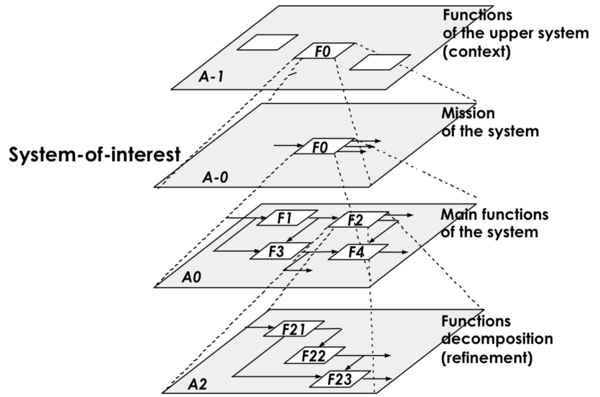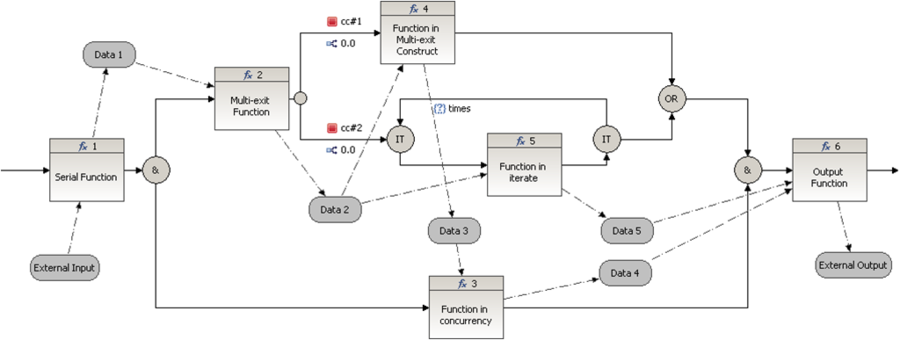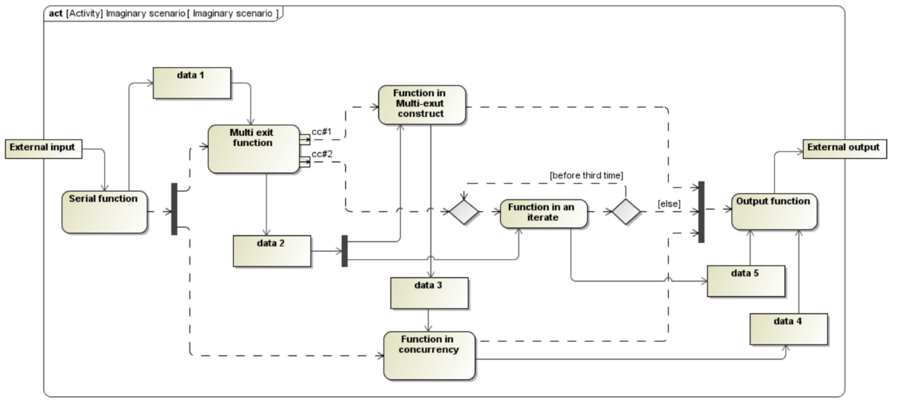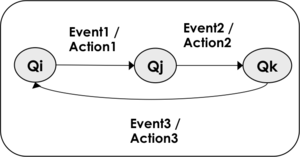Logical Architecture
The purpose of logical architecture definition (or design) is to work out the functionality and behavior of the system while in service.
The logical architecture of a system is composed of a set of related technical concepts and principles that support the logical operation of the system. It is described with views corresponding to viewpoints, and as a minimum, includes a functional architecture / view, a behavioral architecture / view, and a temporal architecture / view. Other additional views are suggested in architectural frameworks, depending on the domain refer to DoDAF, TOGAF, etc.
Concepts and Principles
Functional Architecture / View
A functional architecture is a set of functions and their sub-functions that defines the transformations performed by the system to achieve its mission.
Function and Input-Output Flow - A function is an action that transforms inputs and generates outputs, involving data, materials, and/or energies. These inputs and outputs are the flow items exchanged between functions. The general mathematic notation of a function is y = ƒ(x,t), in which y and x are vectors that may be represented graphically.
In order to define the complete set of functions of the system, one must identify all the functions necessitated by the system and its derived requirements as well as the corresponding inputs and outputs of those functions. Generally speaking, there are two kinds of functions:
- functions that are directly deduced from functional requirements and from interface requirements. These equations express the expected services of a system necessary to meet its system requirements
- functions that are derived and issued from the alternative solutions of physical architecture and are dependent upon the result of the design; additionally, they rely upon on technology choice to implement the logical architecture elements.
Functions Hierarchy/Decomposition of Functions – At the highest level of a hierarchy (Figure 1), it is possible to represent a system as a unique, central function (defined as the system's mission) that in many ways is similar to a "black box" (F0 in plan A-0). In order to understand, in detail, what the system does, this "head-of-hierarchy" (F0) is broken down into sub-functions (F1, F2, F3, F4) grouped to form a sub-level of the hierarchy (plan A0), and so on. Functions of the last level of a functional hierarchy can be called leaf-functions (F21, F22, F23, F24 in plan A2). Hierarchies (or breakdowns) decompose a complex or global function into a set of functions for which physical solutions are known, feasible, or possible to imagine. But a static functional hierarchy does not represent well how the flows of inputs and outputs are exchanged.
Behavioral Architecture / View
A behavioral architecture is an arrangement of functions and their sub-functions as well as interfaces (inputs and outputs) that defines the execution sequencing, conditions for control or data-flow, and the performance level necessary to satisfy the system requirements (ISO/IEC 26702). A behavioral architecture can be described as a set of inter-related scenarios of functions and/or operational modes.
Control (Trigger) - A control flow is an element that activates a function as a condition of its execution. The state of this element, or the condition it represents, activates or deactivates the function (or elements thereof). A control flow can be a signal or an event, such as a switch being moved to the “on” position, an alarm, a trigger, a temperature variation, or the push of a key on a keyboard.
Scenario (of Functions) - A scenario is a chain of functions performed as a sequence that synchronizes the functions between them by using their control flows to achieve a global transformation of inputs into outputs, as seen in the figures below. A scenario of functions expresses the dynamic of an upper level function. A behavioral architecture is developed with considering both scenarios for each level of the functional hierarchy and for each level of the system hierarchy. When representing scenarios of functions and behavioral architectures it is appropriate to use modeling techniques using diagrams, such as Functional Flow Block diagrams (FFBD) (Oliver, Kelliher, and Keegan 1997) or activity diagrams, developed with SysML (OMG. 2010).
Operational Mode - A scenario of functions can be viewed by abstracting the transformation of inputs into outputs of each function and focusing on the active or non-active state of the function and its controls. This view is called a scenario of modes. A scenario of modes is a chain of modes performed as a sequence of transitions between the various modes of the system. The transition from one mode to another is triggered by the arrival of a control flow (event/trigger). An action (function) can be generated within a transition between two modes following the arrival of an event or a trigger, as demonstrated in Figure 2 below:
Behavioral Patterns - When designing scenarios or behavioral architectures, architects may opt to recognize and use known models to represent the expected transformations and behaviors. Patterns are generic basic models that may be more or less sophisticated depending on the complexity of the treatment. A pattern can be represented with different notations. Behavioral design patterns are classified into several categories, which can be seen in the following examples:
- Basic patterns or constructs linking functions - such as sequence, iteration, selection, concurrence, multiple exits, loops with an exit, and replication.
- Complex patterns - such as monitoring a treatment, exchanging a message, man machine interfaces, modes monitoring, real-time monitoring of processes, queue management, and continuous monitoring with supervision.
- Failure detection, identification, and recovery (FDIR) patterns- such as passive redundancies, active redundancies, semi-active redundancies, and treatments with reduced performance.
Temporal Architecture / View
A temporal architecture is a classification of the functions of a system that are derived according to the frequency level of execution. Temporal architecture includes the definition of synchronous and asynchronous aspects of functions. The decision monitoring that occurs inside a system follows the same temporal classification because the decisions are related to the monitoring of functions.
Temporal and Decisional Hierarchy Concept – Not every function of a system is performed at the same frequency. The frequencies change depending on the time and the manner in which the functions are started and executed. One must therefore consider several classes of performance. There are synchronous functions that are executed cyclically and asynchronous functions that are executed following the occurrence of an event or trigger.
To be more specific, "real-time" systems and "command-control" systems combine cyclical operations (synchronous) and factual aspects (asynchronous). Cyclical operations consist of sharing the execution of functions according to frequencies, which depend on either the constraints of capture or dispatching the input/output and control flows. Two types of asynchronous events can be distinguished:
- Disturbances on High Frequencies (bottom of figure 3) - Decisions that are made at either the level they occur or one level above. The goal is to deter disturbances from affecting the low frequencies so that the system continues to achieve its mission objectives. This is the way to introduce exception operations, with the typical example relating to operations concerns, breakdowns, or failures.
- Changes Happening on Low Frequencies (top of figure 3) - - Decisions pertaining to changes that are made at the upper levels. The ultimate goal is to transmit them toward bottom levels to implement the modifications. A typical example relates to operator actions, maintenance operations, etc.
Process Approach
Purpose
The purpose of the logical architecture design process is to define, select, and synthesize a system’s logical architecture to enable it to satisfy and trade-off with the concerned system requirements as well as enable it to operate all operational scenarios of the complete system life. Because of the need for an iterative execution of the design, inputs and outputs evolve incrementally throughout the process. Generic inputs include system requirements, generic design patterns that designers identify and use to answer requirements, outcomes from system analysis processes, and feedback from system verification and validation processes.
Generic outputs are the selected independent logical architecture of the system and include, at minimum, views and models. These involve functional, behavioral, and temporal views, a traceability matrix between logical architecture elements and system requirements, and the rejected solutions’ elements.
Activities of the Process
Major activities and tasks performed during this process include the following:
- Identify and analyze functional and behavioral elements:
- Identify functions, input-output flows, operational modes, transition of modes, and operational scenarios from system requirements by analyzing the functional, interface, and operational requirements:
- Define necessary inputs and controls (energy, material, and data flows) to each function and outputs that result in the deduction of the necessary functions to use, transform, move, and generate the input-output flows.
- Assign system requirements to functional and behavioral elements:
- Formally characterize functions expression and their attributes through the assignment of performance, effectiveness, and constraints requirements. In particular, study the temporal aspects from requirements to assign duration, response time, and frequency to functions.
- Formally characterize the input, output, and control flows expression and their attributes through assignment of interface, effectiveness, operational, temporal and constraints requirements.
- Establish traceability between system requirements and these functional and behavioral elements.
- Define candidate logical architectures. For each candidate:
- Analyze operational modes as stated in the system requirements (if any) and/or use previously defined elements to model sequences of operational modes and the transition of modes. Eventually decompose the modes into sub-modes and then establish for each operational mode one or several scenarios of functions recognizing and/or using relevant generic behavioral patterns.
- Integrate these scenarios of functions in order to get a behavioral architecture model of the system (a complete picture of the dynamic behavior).
- Decompose previously defined logical elements as necessary to look towards implementation.
- Assign and incorporate temporal constraints to previously defined logical elements, such as the period of time, duration, frequency, response-time, timeout, stop conditions, etc.
- Define several levels of execution frequency for functions that correspond to levels of decision in order to monitor system operations, prioritize processing on this time basis, and share out functions among those execution frequency levels to get a temporal architecture model.
- Perform functional failure modes and effects analysis and update the logical architecture elements as necessary.
- Execute the models with simulators (when possible) and tune these models to obtain expected characteristics.
- Synthesize the selected independent logical architecture:
- Select the logical architecture by assessing the candidate logical architectures against assessment criteria (related to system requirements) and compare them, using the system analysis process to perform assessments (see the System Analysis Topic). This selected logical architecture is called “independent logical architecture” because, as much as possible, it is independent of implementation decisions.
- Identify and define derived logical architecture elements created for the necessity of design and corresponding with the derived system requirements and assign these requirements to the appropriate system (current studied system or external systems).
- Verify and validate the selected Logical Architecture models (using as executable models as possible), make corrections as necessary, and establish traceability between system requirements and logical architecture elements.
- Feedback logical architecture definition and system requirements (this activity is performed after the physical architecture definition (design) process):
- Model the “allocated logical architecture” to systems and system elements, if such a representation is possible, and add any functional, behavioral, and temporal elements as needed to synchronize functions and treatments.
- Define or consolidate derived logical and physical elements induced by the selected logical and physical architectures. Define the corresponding derived requirements and allocate them to appropriate logical and physical architectures elements. Incorporate these derived requirements in requirements baselines of impacted systems.
Artifacts and Ontology Elements
This process may create several artifacts, such as:
- system design documents (describe the selected logical and physical architectures)
- system design justification documents (traceability matrices and design choices)
This process handles the ontology elements of Table 1.
| Element | Definition
Attributes (examples) |
|---|---|
| Function | A task, action, or activity performed to achieve a desired outcome. A function uses input flows and generates output flows.
Identifier; name description; duration (execution time). |
| I/O Flow | An input or an output or a trigger of a function (used for input-output flow, control flow). An I/O flow can be made of material and/or energy and/or information.
Identifier; nage; description; type (input, output, trigger); initial quantity; quantity consumed or produced; preconditions; priority; precision; accuracy; concurrency |
| Operational Mode | An operational situation/configuration of a system characterized by its active functions (synonym of state). Inside an operational mode, the system can perform specific operational scenarios and activate the corresponding functions.
Identifier; name description |
| Scenario | A set of actions/functions representing the dynamic of exchanges between the functions allowing the system to achieve a mission or a service.
Identifier; name; description |
| Rationale | Argument that provides the justification for the selection of an engineering element.
Identifier; name; description (rational reasons for relevance of the element) |
| Risk | An event having a probability of occurrence and a gravity degree on its consequence onto the system mission or on other characteristics (used for technical risk in engineering). A risk is the combination of vulnerability and a danger or a threat.
Identifier; name; description; status |
Note: The element scenario is used for logical architecture because, as defined, a scenario includes a large set of functional, behavioral, and temporal elements. Sequences of operational modes and the transition of modes can be used alternatively, depending on the used modeling techniques.
Methods and Modeling Techniques
Logical architecture descriptions use modeling techniques that are grouped under the following types of models. Several methods have been developed to support these types of models (some are executable models):
- Functional models –these include models such as the structured analysis design technique (SADT/IDEF0), system analysis & real time (SA-RT), enhanced Functional Flow Block Diagrams (eFFBD), and the function analysis system technique (FAST).
- Semantic models- these include models such as entities-relationships diagrams, class diagrams, and data flow diagrams.
- Dynamic models – these include such models as state-transition diagrams, state-charts, eFFBDs, state machine diagrams (SysML), activity diagrams (SysML) (OMG. 2010), and petri nets.
Depending on the type of domain (defense, enterprise), architecture frameworks such as DoDAF, TOGAF, Zachman, etc. provide descriptions that can help to represent additional aspects/views of architectures - see section 'Enterprise Architecture Frameworks & Methodologies' in Enterprise Systems Engineering Key Concepts. See also practical means for using general templates in [1]
Practical Considerations
Major pitfalls encountered with logical architecture design are presented in Table 2.
| Pitfall | Description |
|---|---|
| Inputs for design | The major input for design activity is the set of system requirements and there are times that they do not address the right level of design. The consequence is that the designer lets the requirements fall to the side and invents a solution with what he or she understands through the input. |
| Decomposition too deep | A common mistake many beginners in design make that consists of decomposing the functions too deeply or having too many functions and input/output flows in scenarios or in the functional architecture of the current system block. |
| Not considering inputs and outputs together with functions | A current mistake is to consider only the actions supported by functions and decomposing them, while forgetting the inputs and the outputs or considering them too late. Inputs and outputs are integrated parts of a function. |
| Considering static decomposition of functions only | Static function decomposition is the smallest functional design task and answers the question, "How is this done?" The purpose of the status decomposition is to facilitate the management or navigation through the list of functions. The static decomposition should be established only when scenarios have been created and the logical design almost finished. |
| Mixing governance, management, and operation | Governance (strategic monitoring), management (tactical monitoring), and basic operations are often mixed in complex systems. Functional design should deal with behavioral design and with temporal design. |
Proven practices with logical architecture design are presented in Table 3.
| Practice | Description |
|---|---|
| Constitute scenarios of functions | Before constituting a decomposition tree of functions, one must model the behavior of the system, establishing scenarios of functions, and decompose functions as scenarios of sub-functions. |
| Analysis and synthesis cycles | When facing a system that seems to contain a lot of functions, try to synthesize functions into higher abstraction levels of functions with the help of criteria. Do not perform analysis only, but instead, small cycles of analysis (decomposition) and synthesis. The technique of using scenarios includes this design practice. |
| Alternate functional and behavioral views | A function (action verb; e.g. "to move") and its state of execution/operational mode (e.g. "moving") are two similar and complimentary views. Use this to consider a behavioral view of the system that transitions from one operational mode to another. |
| Order to create a scenario of functions | When creating a scenario of functions, it is more efficient from a mouthed viewpoint to first establish the (control) flow of functions, then to add input and output flows, and finally to add triggers or signals for synchronization. |
References
Works Cited
Alexander, C., S. Ishikawa, M. Silverstein, M. Jacobson, I. Fiksdahl-King, and S. Angel. 1977. A Pattern Language: Towns, Buildings, Construction. New York, NY, USA: Oxford University Press.
Buede, D.M. 2009. The engineering design of systems: Models and methods. 2nd ed. Hoboken, NJ, USA: John Wiley & Sons Inc.
Gamma, E., R. Helm, R. Johnson, and J. Vlissides. 1995. Design Patterns: Elements of Reusable Object-Oriented Software. Boston, MA, USA: Addison-Wesley. ISO/IEC/IEEE. 2008. Systems and Software Engineering - System Life Cycle Processes. Geneva, Switzerland: International Organization for Standardization (ISO)/International Electronical Commission (IEC), Institute of Electrical and Electronics Engineers. ISO/IEC/IEEE 15288:2008 (E).
www.iso-architecture.org/42010/templates
Maier, M., and E. Rechtin. 2009. The art of systems architecting. 3rd ed. Boca Raton, FL, USA: CRC Press.
Oliver, D., T. Kelliher, and J. Keegan. 1997. Engineering complex systems with models and objects. New York, NY, USA: McGraw-Hill.
OMG. 2010. OMG Systems Modeling Language specification, version 1.2, July 2010. http://www.omg.org/technology/documents/spec_catalog.htm.
Thome, B. 1993. Systems Engineering, Principles & Practice of Computer-Based Systems Engineering. New York, NY, USA: Wiley.
Primary References
ANSI/IEEE. 2000. Recommended practice for architectural description for software-intensive systems. New York, NY: American National Standards Institute (ANSI)/Institute of Electrical and Electronics Engineers (IEEE), ANSI/IEEE 1471-2000.
INCOSE. 2011. INCOSE Systems Engineering Handbook: A Guide for System Life Cycle Processes and Activities, version 3.2.1. San Diego, CA, USA: International Council on Systems Engineering (INCOSE), INCOSE-TP-2003-002-03.2.1.
ISO/IEC/IEEE. 2008. Systems and Software Engineering - System Life Cycle Processes. Geneva, Switzerland: International Organization for Standardization (ISO)/International Electronical Commission (IEC), Institute of Electrical and Electronics Engineers. ISO/IEC/IEEE 15288:2008 (E).
ISO/IEC/IEEE. 2011. Systems and Software Engineering - Architecture Description. Geneva, Switzerland: International Organization for Standardization (ISO)/International Electrotechnical Commission (IEC)/Institute of Electrical and Electronics Engineers (IEEE), ISO/IEC/IEEE 42010.
Maier, M., and E. Rechtin. 2009. The Art of Systems Architecting. 3rd ed. Boca Raton, FL, USA: CRC Press.
Additional References
Faisandier, A. 2012. Systems Architecture and Design. Belberaud, France: Sinergy'Com.
Oliver, D., T. Kelliher, and J. Keegan. 1997. Engineering Complex Systems with Models and Objects. New York, NY, USA: McGraw-Hill.
Thome, B. 1993. Systems Engineering, Principles & Practice of Computer-Based Systems Engineering. New York, NY, USA: Wiley.
SEBoK Discussion
Please provide your comments and feedback on the SEBoK below. You will need to log in to DISQUS using an existing account (e.g. Yahoo, Google, Facebook, Twitter, etc.) or create a DISQUS account. Simply type your comment in the text field below and DISQUS will guide you through the login or registration steps. Feedback will be archived and used for future updates to the SEBoK. If you provided a comment that is no longer listed, that comment has been adjudicated. You can view adjudication for comments submitted prior to SEBoK v. 1.0 at SEBoK Review and Adjudication. Later comments are addressed and changes are summarized in the Letter from the Editor and Acknowledgements and Release History.
If you would like to provide edits on this article, recommend new content, or make comments on the SEBoK as a whole, please see the SEBoK Sandbox.
blog comments powered by Disqus



